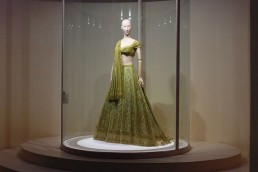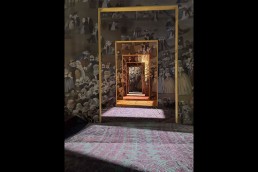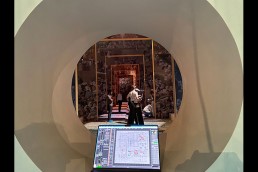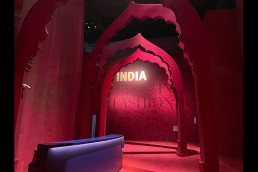This website uses cookies so that we can provide you with the best user experience possible. Cookie information is stored in your browser and performs functions such as recognising you when you return to our website and helping our team to understand which sections of the website you find most interesting and useful.
India in Fashion: The Impact of Indian Dress and Textiles on the Fashionable Imagination
ProjectIndia in Fashion: The Impact of Indian Dress and Textiles on the Fashionable ImaginationLocationMumbai, IndiaArchitectMunro Acoustics, IndiaInstallerSI company Innovative SystemsAcousticianKapil Thirwani Munro Acoustics, IndiaSubmitted byOutboard, TiMax
The prestigious inaugural exhibition of the Nita Mukesh Ambani Cultural Centre in Mumbai, Vogue’s “India in Fashion: The Impact of Indian Dress and Textiles on the Fashionable Imagination”, was a first-of-its-kind exhibition in India.
It required an audio solution that was equal in stature to the visual and historical elements exhibited, which could create multiple zones playing spatial music and effects that segued from zone to zone across 15 different fashion brands or genres, some of which were spatially immersive.
Each zone works independently, starting and stopping automatically without anybody having to touch the system. The 128 speakers required had to be practically invisible, as did any cabling.
It was soon clear to acoustician and designer Kapil Thirwani that: “Genelec 4430 Dante IP speakers and TiMax SoundHub were the only products that would meet the requirement.”
The exhibition, which ran continuously for two months and closed in early June, led visitors around 15 zones to explore India’s rich fashion history and its influence on the West since the 17th century.
Each zone featured a strong theme or era, such as the Mughal chinz hugely popular in the 18th century; the Indian impact on Parisian designers Chanel, Christian Dior and Yves St Laurent; the history of the sari and Western interpretations by Schiaparelli, Balenciaga, Madame Grès and Jean Paul Gaultier; the Hippie Trail section featuring 1960’s Indian-influenced fashion; film costume designers and Bollywood creations; and a Valentino lace wedding outfit made for Nita Mukesh Ambani’s daughter Isha, using thousands of crystal beads that took almost a year to complete.
Some of the zones were made to feel interactive, including the Great Exhibition London 1851, a nod to the Crystal Palace exhibition marking the complex colonial relationship between Britain and India, bringing Indian art and culture to London at the height of the empire. Here, a central display of shoes, jewellery and accessories was mounted on a plinth with 14 speakers underneath. As visitors approached, they were greeted by the chatter and ambience of a bazaar.
“We wanted some of the soundtrack from the adjacent Journey of the Sari zone to blend with this as well, adding to the bazaar ambience,” explains Thirwani.
A stunning centrepiece by House of Worth – the Peacock dress worn by the Vicereine of British India, Lady Curzon to the 1903 Delhi Durbar celebrating the coronation of King Edward VII – was surrounded by silk hangings suspended from the ceiling imprinted with trees and flowers. Visitors were led behind the dress display into a “garden” where a field recording immersed them in
countryside ambience and birdsong and string ensemble accompaniment.
Two TiMax SoundHub-S64s dubbed “Jio1” and “Jio2”, each with 64 inputs and 64 outputs on Dante, together with a laptop PC, each handled one half of the exhibition, playing out a mix of stereo and multi-stem spatial music and soundscape tracks to the 128 Genelec POE-powered speakers.
Running off a single ethernet cable, the IEEE802.3bt High Power PoE-powered speaker incorporates Genelec’s Smart IP Manager which can operate across an unlimited number of zones and include device discovery, a room equalisation toolset, system organisation and status monitoring while supporting external control via third-party hardware or software.
The prime function of TiMax in this scenario was to provide a reliable, single show-in-box solution to handle all system processing, looping audio playback content, immersive audio spatialisation and automated showcontrol scheduling.
The two TiMax SoundHub units were required to achieve this seamlessly and repeatedly across fifteen, independent, themed, spatialised zones, with each zone’s show being started and looped automatically to a date/time scheduling showcontroller in TiMax. Additionally, the client required simplified hands-on control of level and ad-hoc show triggering to manage any special events, TV interviews or out-of-hours sponsor visits should they arise.
Out Board’s Dave Haydon oversaw the creation of the exhibition’s initial showfile templates. Sandunes – Goa-based musicians Sanaya Ardeshir and Krishna Jhaveri – started sending audio content in show files to Haydon in the UK for pre-programming and stress-testing.
He also conducted a series of Zoom workshops with Sandunes, explaining the TiMax software and a pre-programming workflow they could use with TiMax virtually placing four studio monitors, two front and two rear, in each zone. “They could monitor on the four speakers while programming and panning the content around in a small studio space, and TiMax would simultaneously render it to playback and panning as intended to be heard in a real-life setting at the venue,” explains Haydon.
“I also gave them some guidance on what works and what doesn’t work, such as keeping everything quite subtle and not whizzing stuff around people’s heads, which they took onboard. They had a very good grasp of what the technology could do.”
Sanaya commented that, as an artist, it was quite a transition working in multichannel spatial audio and it was a journey of discovery, finding out what works; separating things into surround.” Also on hand to help with TiMax programming was Sandunes tour video director Sourya Sen, who had experience of working with spatial soundscapes.
“We saved the settings and locked the SoundHubs to fade in at 10am then slowly fade out when the gallery closes in the evening,” explains Thirwani. An iPad for each SoundHub running TouchOSC gave the client control of the master level and individual zone levels for out-of-hours VIP visits, press and TV interviews and so on. “We gave the iPads, running on a closed Wi-Fi network, to the floor managers,” he continues. “We had our own UPS power with backup, and the entire show ran for two months with no issues at all.”
Once the technology was in place and the bespoke multi-stem content uploaded, the audio team moved around from zone to zone with a Mac to fine-tune the spatialisation. Dealing with the noise of the technology in use was one of the challenges faced. The Fashion Takes a Trip section, part of the immersive Hippie Trail zone, is a prime example as it featured a backdrop of projected images with fan noise emitting from the multiple ceiling-mounted projectors.
This necessitated some slight re-mixing by Sandunes in Logic., and then the content was re-loaded back into TiMax in a manner which kept all TiMax spatialisation programming intact.






